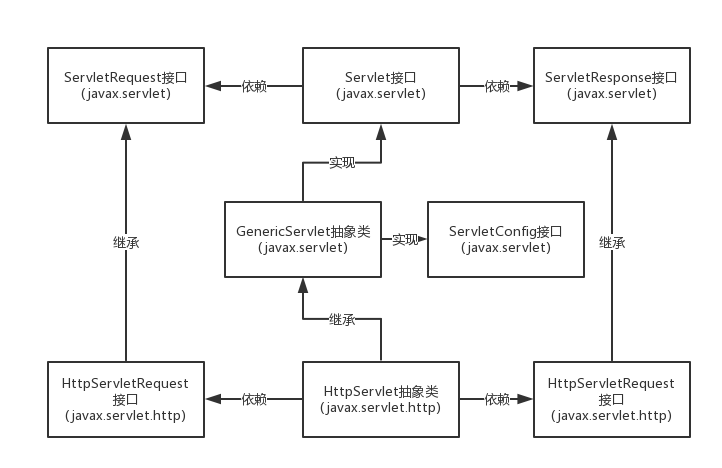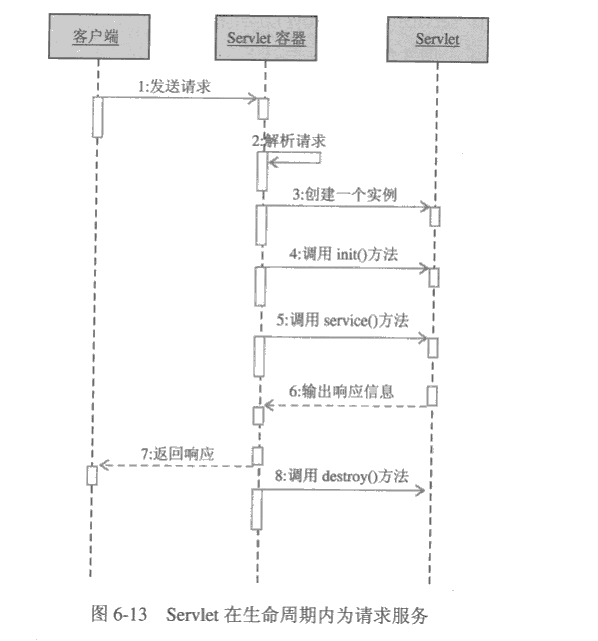配置環境:https://www.cnblogs.com/qq965921539/p/9821374.html
簡介:
Servlet是Sun公司提供的一種實現動態網頁的解決方案,在制定J2EE時引入它作為實現了基于Java語言的動態技術,目前流行的Web框架基本都基于Servlet技術,只有掌握了Servlet,才能真正掌握Java Web編程的核心和精髓。
Servlet是運行在Servlet容器中的Java類,它能處理Web客戶的HTTP請求,并產生HTTP響應。
Servlet對請求的處理和響應過程可進一步細分為以下幾個步驟:
1.接收HTTP請求
2.取得請求信息,包括請求頭和請求參數數據
3.調用其它Java類方法,完成具體的業務功能
4.實現到其他Web組件的跳轉(包括重定向或請求轉發)
5.生成HTTP響應(包括HTML或非HTML響應)
?
優點:
Servlet有以下幾個優點:
1.高效,在Servlet中,每個請求由一個輕量級的java線程處理;
2.方便,提供了大量實用工具例程,這個在后面會慢慢敘述;
3.功能強大,繼承了Java的優點,能夠直接和Web服務器交互,還能夠在各個程序之間共享數據;
4.可移植性好,Servlet由Java語言編寫,并且其API具有完善的標準,支持Servlet規范的容器都可以運行Servlet程序,如Tomcat和Resin等。
Servlet體系結構:
Servlet是使用Servlet API及相關類和方法的Java程序,Servlet API包含兩個軟件包:
javax.servlet包:包含支持所有協議的通用的Web組件接口和類,如ServletRequest接口,ServletResponse接口
javax.servlet.http包:包含支持HTTP協議的接口和類,如HttpServletRequest接口,HttpServletResponse接口
Servet API的主要接口和類之間的關系為:

Servlet接口:
所有的Servlet都必須直接或間接地實現javax.servlet.Servlet接口。Servlet接口規定了必須由Servlet類實現并且由Servlet引擎識別和管理的方法集。Servlet接口的基本目標是提供與Servlet生命周期相關的方法,如init(),service()和destory()等,下述示例為Servlet接口的源代碼:
1 package javax.servlet; 2 3 import java.io.IOException; 4 5 public interface Servlet { 6 void init(ServletConfig var1) throws ServletException; 7 8 ServletConfig getServletConfig(); 9 10 void service(ServletRequest var1, ServletResponse var2) throws ServletException, IOException; 11 12 String getServletInfo(); 13 14 void destroy(); 15 }
1.init(),初始化servlet對象,Servlet實例化后,容器調用該方法進行初始化工作。ServletAPI規定該方法只能被調用一次,如果此方法沒有正常結束就會拋出一個ServletException異常,一旦拋出該異常,Servlet將不再執行。
2.service(ServletRequest var1, ServletResponse var2),接受客戶端請求對象,執行業務操作,利用響應對象響應客戶端請求。
3.destroy(),當容器監測到一個servlet從服務中被移除時,容器調用該方法,釋放資源,調用該方法前必須給service()足夠時間來結束執行。
4.getServletConfig(),ServletConfig是容器向servlet傳遞參數的載體,此方法可以讓Servlet在任何時候獲得ServletConfig對象。
5.getServletInfo(),返回一個String對象獲取servlet相關信息。
GenericServlet類:
GenericServlet類是一個抽象類,是Servlet接口的直接實現,除service()方法之外還提供了其他有關Servlet生命周期的方法。這意味著只需通過簡單地擴展GenericServlet和實現servlet方法就可以編寫一個基本的Servlet。
1 package javax.servlet; 2 3 import java.io.IOException; 4 import java.io.Serializable; 5 import java.util.Enumeration; 6 7 public abstract class GenericServlet implements Servlet, ServletConfig, Serializable { 8 private static final long serialVersionUID = 1L; 9 private transient ServletConfig config; 10 11 public GenericServlet() { 12 } 13 14 public void destroy() { 15 } 16 17 public String getInitParameter(String name) { 18 return this.getServletConfig().getInitParameter(name); 19 } 20 21 public Enumeration<String> getInitParameterNames() { 22 return this.getServletConfig().getInitParameterNames(); 23 } 24 25 public ServletConfig getServletConfig() { 26 return this.config; 27 } 28 29 public ServletContext getServletContext() { 30 return this.getServletConfig().getServletContext(); 31 } 32 33 public String getServletInfo() { 34 return ""; 35 } 36 37 public void init(ServletConfig config) throws ServletException { 38 this.config = config; 39 this.init(); 40 } 41 42 public void init() throws ServletException { 43 } 44 45 public void log(String msg) { 46 this.getServletContext().log(this.getServletName() + ": " + msg); 47 } 48 49 public void log(String message, Throwable t) { 50 this.getServletContext().log(this.getServletName() + ": " + message, t); 51 } 52 53 public abstract void service(ServletRequest var1, ServletResponse var2) throws ServletException, IOException; 54 55 public String getServletName() { 56 return this.config.getServletName(); 57 } 58 }
init(ServletConfig config:該方法來源于Servlet接口,覆寫該方法,必須調用super.init(config)
init():該方法重載Servlet.init(ServletConfig config)方法而無需調用super.init(config)。而ServletConfig對象依然可以通過調用getServletConfig()方法獲得。
destory()方法作用與Servlet接口中的方法相同,略。
getInitParameter():返回一個包含初始化變量的值的字符串,如果變量不存在則返回null,該方法從servlet的ServletConfig變量獲得命名變量的值。
getInitParameterNames():該方法返回一個包含所有初始化變量的枚舉函數。如果沒有初始化變量,則返回一個空枚舉函數。
getServletConfig():返回一個servlet的ServletConfig對象getServletContext()方法與ServletConfig.getServletContext()相同,略。
getServletInfo():該方法來源于Servlet接口,覆寫該方法以產生有意義的信息。(如:版本號、版權、作者等)
log(java.lang.String msg):public void log(java.lang.String msg)該方法把指定的信息寫入一個日志文件,見ServletContext.log(String)。
log(java.lang.String message,java.lang.Throwable t):public void log(java.lang.String message,java.lang.Throwable t) 該方法把解釋性的內容和拋出的例外信息寫入一個日志文件。
service():這是一個抽象的方法,當為執行網絡請求繼承GenericServlet類時必須實現它,該方法必須由servlet容器調用以允許servlet 對請求作出響應。見Servlet.service(javax.servlet.ServletRequest, javax.servlet.ServletResponse)。
getServletName():見ServletConfig.getServletName()。
HttpServlet類:
這個是重點啦(拍桌子)!HttpServlet類擴展了GenericServlet類并且對Servlet接口提供了與HTTP相關的實現,是在Web開發中定義Servlet最常使用的類。HttpServlet類中的主要方法的源代碼如下所示:
1 // 2 // Source code recreated from a .class file by IntelliJ IDEA 3 // (powered by Fernflower decompiler) 4 // 5 6 package javax.servlet.http; 7 8 import java.io.IOException; 9 import java.lang.reflect.InvocationTargetException; 10 import java.lang.reflect.Method; 11 import java.text.MessageFormat; 12 import java.util.Enumeration; 13 import java.util.ResourceBundle; 14 import javax.servlet.DispatcherType; 15 import javax.servlet.GenericServlet; 16 import javax.servlet.ServletException; 17 import javax.servlet.ServletOutputStream; 18 import javax.servlet.ServletRequest; 19 import javax.servlet.ServletResponse; 20 21 public abstract class HttpServlet extends GenericServlet { 22 private static final long serialVersionUID = 1L; 23 private static final String METHOD_DELETE = "DELETE"; 24 private static final String METHOD_HEAD = "HEAD"; 25 private static final String METHOD_GET = "GET"; 26 private static final String METHOD_OPTIONS = "OPTIONS"; 27 private static final String METHOD_POST = "POST"; 28 private static final String METHOD_PUT = "PUT"; 29 private static final String METHOD_TRACE = "TRACE"; 30 private static final String HEADER_IFMODSINCE = "If-Modified-Since"; 31 private static final String HEADER_LASTMOD = "Last-Modified"; 32 private static final String LSTRING_FILE = "javax.servlet.http.LocalStrings"; 33 private static final ResourceBundle lStrings = ResourceBundle.getBundle("javax.servlet.http.LocalStrings"); 34 35 public HttpServlet() { 36 } 37 38 protected void doGet(HttpServletRequest req, HttpServletResponse resp) throws ServletException, IOException { 39 String protocol = req.getProtocol(); 40 String msg = lStrings.getString("http.method_get_not_supported"); 41 if (protocol.endsWith("1.1")) { 42 resp.sendError(405, msg); 43 } else { 44 resp.sendError(400, msg); 45 } 46 47 } 48 49 protected long getLastModified(HttpServletRequest req) { 50 return -1L; 51 } 52 53 protected void doHead(HttpServletRequest req, HttpServletResponse resp) throws ServletException, IOException { 54 if (DispatcherType.INCLUDE.equals(req.getDispatcherType())) { 55 this.doGet(req, resp); 56 } else { 57 NoBodyResponse response = new NoBodyResponse(resp); 58 this.doGet(req, response); 59 response.setContentLength(); 60 } 61 62 } 63 64 protected void doPost(HttpServletRequest req, HttpServletResponse resp) throws ServletException, IOException { 65 String protocol = req.getProtocol(); 66 String msg = lStrings.getString("http.method_post_not_supported"); 67 if (protocol.endsWith("1.1")) { 68 resp.sendError(405, msg); 69 } else { 70 resp.sendError(400, msg); 71 } 72 73 } 74 75 protected void doPut(HttpServletRequest req, HttpServletResponse resp) throws ServletException, IOException { 76 String protocol = req.getProtocol(); 77 String msg = lStrings.getString("http.method_put_not_supported"); 78 if (protocol.endsWith("1.1")) { 79 resp.sendError(405, msg); 80 } else { 81 resp.sendError(400, msg); 82 } 83 84 } 85 86 protected void doDelete(HttpServletRequest req, HttpServletResponse resp) throws ServletException, IOException { 87 String protocol = req.getProtocol(); 88 String msg = lStrings.getString("http.method_delete_not_supported"); 89 if (protocol.endsWith("1.1")) { 90 resp.sendError(405, msg); 91 } else { 92 resp.sendError(400, msg); 93 } 94 95 } 96 97 private static Method[] getAllDeclaredMethods(Class<?> c) { 98 if (c.equals(HttpServlet.class)) { 99 return null; 100 } else { 101 Method[] parentMethods = getAllDeclaredMethods(c.getSuperclass()); 102 Method[] thisMethods = c.getDeclaredMethods(); 103 if (parentMethods != null && parentMethods.length > 0) { 104 Method[] allMethods = new Method[parentMethods.length + thisMethods.length]; 105 System.arraycopy(parentMethods, 0, allMethods, 0, parentMethods.length); 106 System.arraycopy(thisMethods, 0, allMethods, parentMethods.length, thisMethods.length); 107 thisMethods = allMethods; 108 } 109 110 return thisMethods; 111 } 112 } 113 114 protected void doOptions(HttpServletRequest req, HttpServletResponse resp) throws ServletException, IOException { 115 Method[] methods = getAllDeclaredMethods(this.getClass()); 116 boolean ALLOW_GET = false; 117 boolean ALLOW_HEAD = false; 118 boolean ALLOW_POST = false; 119 boolean ALLOW_PUT = false; 120 boolean ALLOW_DELETE = false; 121 boolean ALLOW_TRACE = true; 122 boolean ALLOW_OPTIONS = true; 123 Class clazz = null; 124 125 try { 126 clazz = Class.forName("org.apache.catalina.connector.RequestFacade"); 127 Method getAllowTrace = clazz.getMethod("getAllowTrace", (Class[])null); 128 ALLOW_TRACE = (Boolean)getAllowTrace.invoke(req, (Object[])null); 129 } catch (NoSuchMethodException | SecurityException | IllegalAccessException | IllegalArgumentException | InvocationTargetException | ClassNotFoundException var14) { 130 ; 131 } 132 133 for(int i = 0; i < methods.length; ++i) { 134 Method m = methods[i]; 135 if (m.getName().equals("doGet")) { 136 ALLOW_GET = true; 137 ALLOW_HEAD = true; 138 } 139 140 if (m.getName().equals("doPost")) { 141 ALLOW_POST = true; 142 } 143 144 if (m.getName().equals("doPut")) { 145 ALLOW_PUT = true; 146 } 147 148 if (m.getName().equals("doDelete")) { 149 ALLOW_DELETE = true; 150 } 151 } 152 153 String allow = null; 154 if (ALLOW_GET) { 155 allow = "GET"; 156 } 157 158 if (ALLOW_HEAD) { 159 if (allow == null) { 160 allow = "HEAD"; 161 } else { 162 allow = allow + ", HEAD"; 163 } 164 } 165 166 if (ALLOW_POST) { 167 if (allow == null) { 168 allow = "POST"; 169 } else { 170 allow = allow + ", POST"; 171 } 172 } 173 174 if (ALLOW_PUT) { 175 if (allow == null) { 176 allow = "PUT"; 177 } else { 178 allow = allow + ", PUT"; 179 } 180 } 181 182 if (ALLOW_DELETE) { 183 if (allow == null) { 184 allow = "DELETE"; 185 } else { 186 allow = allow + ", DELETE"; 187 } 188 } 189 190 if (ALLOW_TRACE) { 191 if (allow == null) { 192 allow = "TRACE"; 193 } else { 194 allow = allow + ", TRACE"; 195 } 196 } 197 198 if (ALLOW_OPTIONS) { 199 if (allow == null) { 200 allow = "OPTIONS"; 201 } else { 202 allow = allow + ", OPTIONS"; 203 } 204 } 205 206 resp.setHeader("Allow", allow); 207 } 208 209 protected void doTrace(HttpServletRequest req, HttpServletResponse resp) throws ServletException, IOException { 210 String CRLF = "\r\n"; 211 StringBuilder buffer = (new StringBuilder("TRACE ")).append(req.getRequestURI()).append(" ").append(req.getProtocol()); 212 Enumeration reqHeaderEnum = req.getHeaderNames(); 213 214 while(reqHeaderEnum.hasMoreElements()) { 215 String headerName = (String)reqHeaderEnum.nextElement(); 216 buffer.append(CRLF).append(headerName).append(": ").append(req.getHeader(headerName)); 217 } 218 219 buffer.append(CRLF); 220 int responseLength = buffer.length(); 221 resp.setContentType("message/http"); 222 resp.setContentLength(responseLength); 223 ServletOutputStream out = resp.getOutputStream(); 224 out.print(buffer.toString()); 225 out.close(); 226 } 227 228 protected void service(HttpServletRequest req, HttpServletResponse resp) throws ServletException, IOException { 229 String method = req.getMethod(); 230 long lastModified; 231 if (method.equals("GET")) { 232 lastModified = this.getLastModified(req); 233 if (lastModified == -1L) { 234 this.doGet(req, resp); 235 } else { 236 long ifModifiedSince; 237 try { 238 ifModifiedSince = req.getDateHeader("If-Modified-Since"); 239 } catch (IllegalArgumentException var9) { 240 ifModifiedSince = -1L; 241 } 242 243 if (ifModifiedSince < lastModified / 1000L * 1000L) { 244 this.maybeSetLastModified(resp, lastModified); 245 this.doGet(req, resp); 246 } else { 247 resp.setStatus(304); 248 } 249 } 250 } else if (method.equals("HEAD")) { 251 lastModified = this.getLastModified(req); 252 this.maybeSetLastModified(resp, lastModified); 253 this.doHead(req, resp); 254 } else if (method.equals("POST")) { 255 this.doPost(req, resp); 256 } else if (method.equals("PUT")) { 257 this.doPut(req, resp); 258 } else if (method.equals("DELETE")) { 259 this.doDelete(req, resp); 260 } else if (method.equals("OPTIONS")) { 261 this.doOptions(req, resp); 262 } else if (method.equals("TRACE")) { 263 this.doTrace(req, resp); 264 } else { 265 String errMsg = lStrings.getString("http.method_not_implemented"); 266 Object[] errArgs = new Object[]{method}; 267 errMsg = MessageFormat.format(errMsg, errArgs); 268 resp.sendError(501, errMsg); 269 } 270 271 } 272 273 private void maybeSetLastModified(HttpServletResponse resp, long lastModified) { 274 if (!resp.containsHeader("Last-Modified")) { 275 if (lastModified >= 0L) { 276 resp.setDateHeader("Last-Modified", lastModified); 277 } 278 279 } 280 } 281 282 public void service(ServletRequest req, ServletResponse res) throws ServletException, IOException { 283 HttpServletRequest request; 284 HttpServletResponse response; 285 try { 286 request = (HttpServletRequest)req; 287 response = (HttpServletResponse)res; 288 } catch (ClassCastException var6) { 289 throw new ServletException("non-HTTP request or response"); 290 } 291 292 this.service(request, response); 293 } 294 }
HttpServlet雖然看起來很長,但由于前兩個類的結構已趨于完善,主要方法也不多:
service(ServletRequest req, ServletResponse res):HttpServlet在實現Servlet接口時,重寫了service()方法,該方法會自動判斷用戶的請求方式:若為GET請求,則調用doGet()方法,若為POST請求,則調用doPost方法。如果Servlet收到一個HTTP請求而沒有重載相應的do方法,它就返回一個說明此方法對本資源不可用的標準HTTP錯誤
doGet(ServletRequest req, ServletResponse res):被本類的service方法調用,用來處理一個HTTP GET請求
doPost(ServletRequest req, ServletResponse res):被本類的service方法調用,用來處理一個HTTP POST請求
HttpServlet作為HTTP請求的分發器,除了提供對GET和POST請求的處理方法doGet()和doPost()之外,對于其他請求類型如HEAD,OPTIONS,DELETE,PUT,TRACE也提供了相應的處理方法,如doHead(),doOptions等等
HttpServlet指能夠處理HTTP請求的Servlet,開發人員在編寫Servlet時,通常應繼承這個類,而避免去直接實現Servlet接口
?
下面是一個正常能夠處理請求的Servlet基本結構,我們在后面也主要使用這種結構:
1 package com.Servlet; 2 3 import javax.servlet.ServletConfig; 4 import javax.servlet.ServletException; 5 import javax.servlet.annotation.WebServlet; 6 import javax.servlet.http.HttpServlet; 7 import javax.servlet.http.HttpServletRequest; 8 import javax.servlet.http.HttpServletResponse; 9 import java.io.IOException; 10 11 @WebServlet(name = "SimpleServlet") 12 public class SimpleServlet extends HttpServlet { 13 public SimpleServlet(){ 14 super(); 15 } 16 17 public void init(ServletConfig servletConfig) throws ServletException{ 18 //初始化方法 19 } 20 21 public void destroy() { 22 //銷毀方法 23 } 24 25 protected void doPost(HttpServletRequest request, HttpServletResponse response) throws ServletException, IOException { 26 //處理POST請求時調用的方法 27 } 28 29 protected void doGet(HttpServletRequest request, HttpServletResponse response) throws ServletException, IOException { 30 //處理GET請求時調用的方法 31 } 32 }
Servlet生命周期:
Servlet生命周期有七種狀態:創捷,初始化,服務可用,服務不可用,處理請求,終止服務,銷毀
根據七種狀態可以又分為四個階段:
1.加載和實例化:在服務器運行中,客戶機首次向Servlet發出請求時或者再重新裝入Servlet時(如服務器重新啟動,Servlet被修改)或配置了自動裝入選項時(load-on-startup),服務器在啟動時會自動裝入此Servlet
2.初始化:調用上面方法中的init(ServletConfig config)來對Servlet實例進行初始化,成功時進入服務可用狀態,失敗時Servlet容器會從運行環境中清除掉該實例,運行出現異常時進入服務不可用狀態,維護人員也可以設置不可用狀態或從不可用變成可用
3.處理請求:服務器收到客戶端請求時會為該請求創建一個“請求”對象和一個相應對象并調用service()方法,service()方法可能被多次調用,多個客戶端訪問某個Servlet的service方法時,服務器會為每個請求創建一個線程來減少等待時間
4.銷毀:當Servlet容器需要終止Servlet時,它會先調用destroy()方法來釋放資源,調用該方法前必須讓所有service()的線程完成實行,該方法完成后,Servlet容器必須釋放該實例以便被垃圾回收
時序圖:

?

![【洛谷 P1659】 [國家集訓隊]拉拉隊排練(manacher)](http://pic.xiahunao.cn/【洛谷 P1659】 [國家集訓隊]拉拉隊排練(manacher))





 介紹)

)






)


